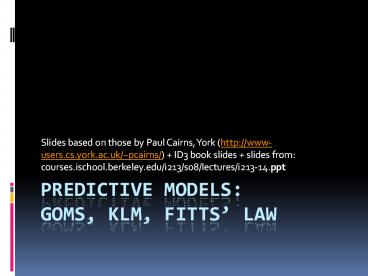Predictive models: GOMS, KLM, Fitts PowerPoint PPT Presentation
Title: Predictive models: GOMS, KLM, Fitts
1
Predictive modelsGOMS, KLM, Fitts Law
- Slides based on those by Paul Cairns, York
(http//www-users.cs.york.ac.uk/pcairns/) ID3
book slides slides from courses.ischool.berkele
y.edu/i213/s08/lectures/i213-14.ppt
2
Predictive models
- Provide a way of evaluating products or designs
without directly involving users. - Less expensive than user testing.
- Usefulness limited to systems with predictable
tasks - e.g., telephone answering systems,
mobiles, cell phones, etc. - Based on expert error-free behavior.
3
GOMS
- Goals what the user wants to achieve eg. find a
website. - Operators - the cognitive processes physical
actions needed to attain goals, eg. decide which
search engine to use. - Methods - the procedures to accomplish the goals,
eg. drag mouse over field, type in keywords,
press the go button. - Selection rules - decide which method to select
when there is more than one.
4
Keystroke level model
- GOMS has also been developed to provide a
quantitative model - the keystroke level model. - The keystroke model allows predictions to be made
about how long it takes an expert user to perform
a task.
5
Response times for keystroke level operators
(Card et al., 1983)
6
Summing together
7
Using KLM to calculate time to change gaze
(Holleis et al., 2007)
Had to add new operators (e.g., Macro Attention
shift)
8
Fitts Law (Fitts, 1954)
- Fitts Law predicts that the time to point at an
object using a device is a function of the
distance from the target object the objects
size. - The further away the smaller the object, the
longer the time to locate it point to it. - Fitts Law is useful for evaluating systems for
which the time to locate an object is important,
e.g., a cell phone,a handheld devices.
9
Fitts Law
- Models movement time for selection
- Movement time for a rehearsed task
- Increases with distance to target (d)
- Decreases with width of target (s)
- Depends only on relative precision (d/s),
assuming target is within arms reach - First demonstrated for tapping with finger (Fitts
1954), later extrapolated to mouse and other
input devices
Adapted from Hearst, Newstetter, Martin
10
Fitts Law Equation
- Tmsec a b log2 (d/s 1)
- a, b empirically-derived constants
- d distance, s width of target
- ID (Index of Difficulty) log2 (d/s 1)
d
s
Adapted from Robert Miller
11
A Fitts law demo
- Interactive Fitts' Law talk
12
Fitts Law Intuition
- Time depends on relative precision (d/s)
- Time is not limited by motor activity of moving
your arm / hand, but rather by the cognitive
activity of keeping on track - Below, time will be the same because the ratio
d/s is the same
Target 2
Target 1
13
Fitts Law Examples
Target 1
Target 2
Target 1
Target 2
Adapted from Hearst, Irani
14
Determining a,b Constants
- Conduct experiments varying d,s but keeping
everything else the same - Measure execution time, error rate, accuracy
- Exclude erroneous data
- Perform linear regression
Adapted from Hearst, Irani
15
ExerciseFitts Law
- Visit Togs website and do Togs quiz, designed
to give you fitts! - http//www.asktog.com/columns/022DesignedToGiveFi
tts.html
16
Fitts in Practice
- Microsoft Toolbars allow you to either keep or
remove the labels under Toolbar buttons - According to Fitts Law, which is more efficient?
Adapted from Hearst, Irani
Source http//www.asktog.com/columns/022DesignedT
oGiveFitts.html
17
Fitts in Practice
- You have a toolbar with 16 icons, each with
dimensions of 16x16 - Without moving the array from the left edge of
the screen, or changing the size of the icons,
how can you make this more efficient?
Adapted from Hearst, Irani
18
Fitts in Practice
- Answer Line up all 16 icons on the left hand
edge of the screen - Make sure that each button can be activated up
the last pixel on the left hand edge - Why? Because you cannot move your mouse off of
the screen, the effective width s is infinite
Adapted from Hearst, Irani
19
Impact in HCI
- Reduce ID
- Bigger icons, more space
- Compare IP
- Capacity of input devices
- Put things in edges and corners
20
Deconstructing Fitts
- Ecological validity
- Construct validity
21
What Fitts did
W
D
22
What we apply it to
23
Correcting for W
- W actual cross-section
- Smaller of W and H
- Area, W x H
- Sum, W H
- Stick with W
- Which is best?
24
Toolbars
- Annoying or useful?
- Edges and corners?
25
Novel interactions
- Artificially increasing W
- Sticky buttons
- Bubbles
- Changing select
- Goal-crossing
26
Advanced Fitts Law
- Fitts law as a model
- Steering law
- Games
- Menu navigation
- VE/VR?
27
Steering Law
- Applies same principles to steering through a
tunnel (Accot, Zhai 1997) - Must keep the pointer within the boundaries
throughout, not only at the target - In KLM, Fitts Law used for pointing, Steering
Law used for drawing
D
S
28
Steering Law Equation
- Tmsec a b (d/s)
- a, b empirically-derived constants
- d distance, s width of tunnel
- ID (Index of Difficulty) (d/s)
- Index of Difficulty now linear, not logarithmic
- (i.e. steering is more difficult then pointing)
D
S
Adapted from Robert Miller
29
Source http//linuxbook.orbdesigns.com/ch09/btlb_
c09.html

